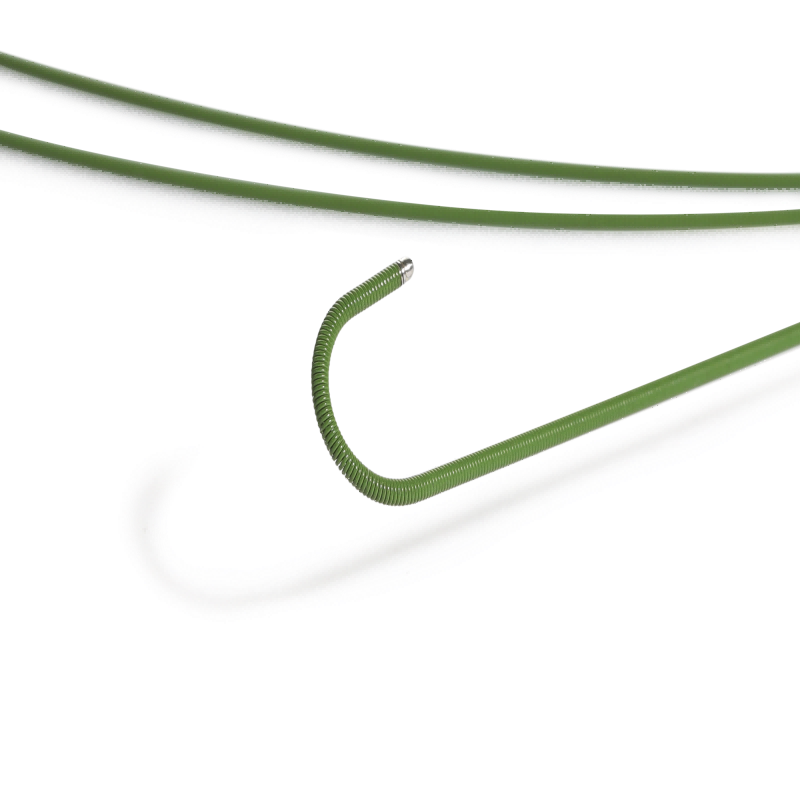Movable-Core Guidewire
The Movable-Core Guidewire is composed of a flexible outer wire and a movable core, both typically made of materials such as stainless steel or nitinol. The outer wire provides support and flexibility for navigating through blood vessels, while the movable core allows for independent movement within the outer wire, providing precise control and maneuverability during procedures. Some wire guides may feature a hydrophilic coating to facilitate smooth advancement through the vasculature and reduce the risk of vessel trauma. Additionally, radiopaque markers on the wire guide enhance visibility under fluoroscopy, aiding in the accurate placement of catheters and other medical devices.
| Structure | Specification(inch) | Length(cm) | Tip shape | Classification |
| Core wire, winding wire and safety wire; The material is 304V stainless steel; The guide wire is PTFE coated. | 0.035″ | 125/150 | J-tip, Straight | Therapeutic Guidewire Coronary Intervention/Peripheral Intervention |
- 1. Uniform surface finish
- 2. Minimal insertion and withdrawal force
- 1. Easy navigation
- 2.Versatility of tip shapes and flexibilities
- 3. Excellent maneuverability
- 4. Finger straightenability
- Independent Core Movement: The Movable-Core Guidewire can be advanced or retracted independently of the outer wire, providing precise control and maneuverability during procedures.
- Flexible Outer Wire: The outer wire is highly flexible, allowing for navigation through tortuous vessels and complex anatomical structures.
- Radiopaque Markers: Radiopaque markers on the wire guide enhance visibility under fluoroscopy, aiding in the accurate placement of catheters and other medical devices.
- Smooth Transition: The wire guide is designed with a smooth transition from the tip to the shaft, minimizing trauma to the vessel during navigation.
- Variety of Lengths and Diameters: Wire guides are available in various lengths and diameters to accommodate different procedural requirements and patient anatomies.
A Movable-Core Guidewire consists of a flexible, slender wire with a movable core that allows for precise control and navigation through blood vessels during procedures. The core of the wire guide can be advanced or retracted independently of the outer wire, providing flexibility and maneuverability in navigating through complex anatomical structures.
- Peripheral Vascular Interventions: Facilitate access to peripheral blood vessels for procedures such as angiography, angioplasty, and stenting.
- Cardiac Catheterization: Provide vascular access for diagnostic and interventional cardiac procedures such as angiography, angioplasty, and stenting.
- Neurointerventional Procedures: Enable access to the cerebral vasculature for procedures such as embolization, thrombectomy, and aneurysm coiling.
- Interventional Radiology: Provide access to blood vessels for procedures such as embolization, venous access, and drainage catheter placement.
- Electrophysiology Procedures: Facilitate access to the cardiac vasculature for procedures such as pacemaker and defibrillator lead placement, and ablation therapy.
Related products
-
PTCA Guidewire
The Demax PTCA Guidewire is a specialized medical device designed to facilitate the precise navigation of catheters and balloons during percutaneous transluminal coronary angioplasty (PTCA) procedures. Crafted with precision and utilizing high-quality materials, this guidewire offers exceptional performance, flexibility, and durability, making it an indispensable tool for interventional cardiologists performing coronary interventions.
-
Pre-shaped Guidewire
The Pre-shaped Guidewire is a specialized medical device used in various diagnostic and interventional procedures to navigate through anatomical structures with precision. Crafted with precision and using high-quality materials, this guidewire offers exceptional flexibility, durability, and maneuverability, making it an indispensable tool for healthcare professionals performing a wide range of procedures.
-
Hydrophilic Guidewire
The composition of Hydrophilic Coated Guidewires typically consists of a core material, such as stainless steel or nitinol, surrounded by a hydrophilic polymer coating. Stainless steel provides the necessary rigidity and structural integrity to the guidewire, enabling it to withstand the forces encountered during navigation through the body. On the other hand, nitinol, a shape-memory alloy, offers flexibility and elasticity, allowing the guidewire to adapt to the contours of anatomical structures without sacrificing durability.
The hydrophilic coating, usually composed of PTFE or a similar material, serves as a lubricious layer that reduces friction and enhances the guidewire’s ability to glide smoothly through the vasculature or other bodily passages. This coating undergoes a specialized manufacturing process to ensure uniformity and durability, enabling the guidewire to maintain its hydrophilic properties throughout the duration of the procedure.
-
Angiography Guidewire
Angiography guidewires manufactured by Demax are meticulously crafted from high-grade materials such as stainless steel or nitinol. These materials offer excellent mechanical properties, including flexibility, durability, and kink resistance, essential for navigating through tortuous vessels and performing intricate vascular procedures with precision. Additionally, some guidewires feature hydrophilic coatings to enhance lubricity and minimize friction during navigation, further improving procedural success rates and patient comfort. With their advanced composition and precision engineering, Demax angiography guidewires set the standard for excellence in vascular intervention tools, empowering healthcare professionals to deliver superior care to their patients.




